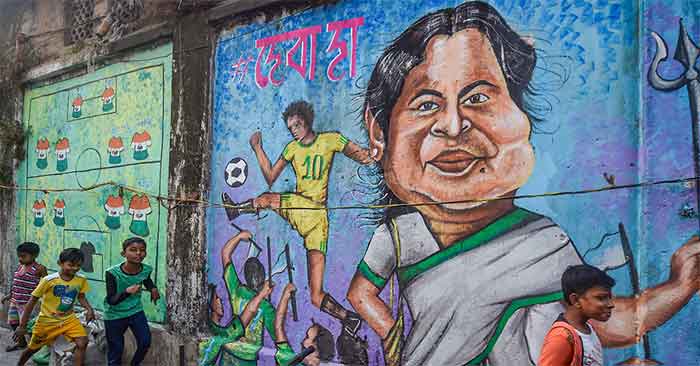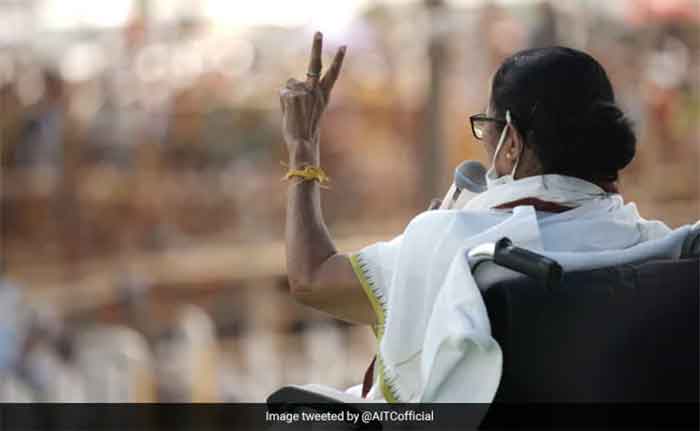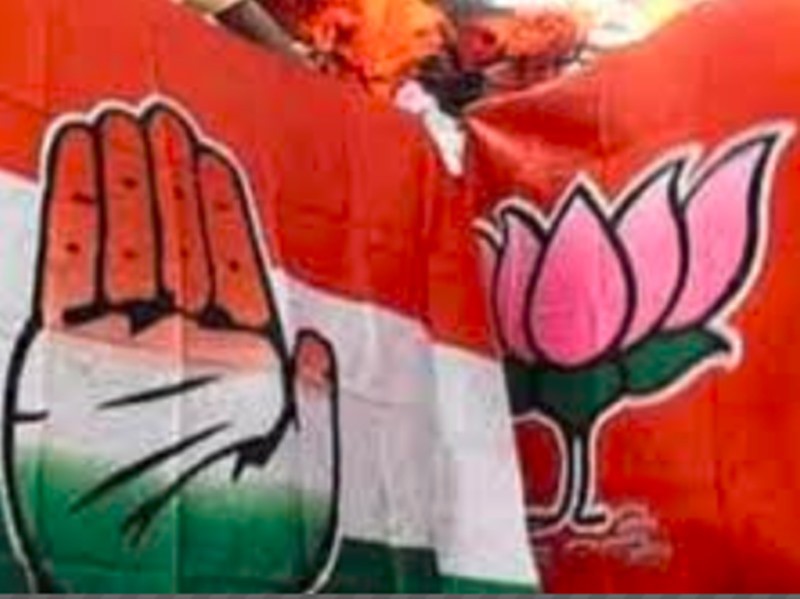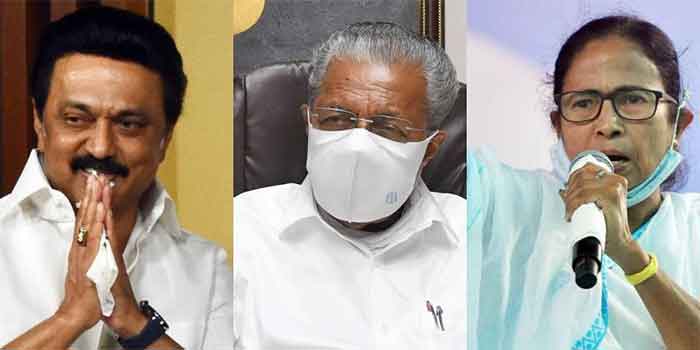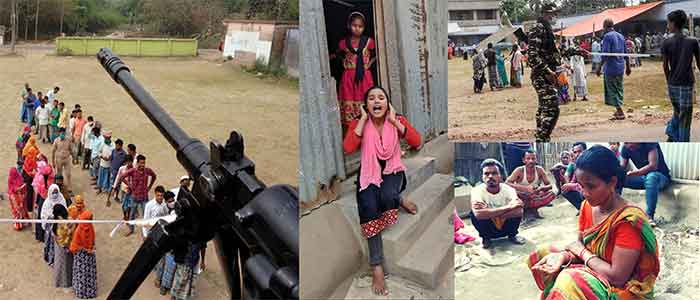
What an assembly election! Eight Phases! From the first voting date to the last voting date the election is spread over 40 days. And from the first official announcement date to the date of counting – it is a period of two months! This will be some three weeks longer due to the death of candidates of two seats due to Covid. The disease is spreading with accelerated speed, yet the Election Commission did not think of managing the exercise with shorter routine. 8-phase election in a particular state with such a planning that with help a party, no consideration of covid spread in election rallies, and there were so many good works including these which should not go unappreciated. But this is only a fraction of the picture.
When the news of ‘Five Shot Dead in Cooch Behar Firing’ arrived on the evening of April 10, the fourth phase of the unheard of 8-phase long polling for West Bengal assembly, it reminded, do not know why, another news of ‘Five Shot Dead in Cooch Behar Firing’ in another April, 70 years back, 1951. A protest rally of several thousand against high food prices was welcomed by police firing: Bakul Talukdar (7), Bandana Talukdar (13), Kabita Basu (18), Badal Biswas (22) and Satish Debnath (23). 1951 was a very bad year for this land; from Punjab to Bengal everywhere there was scarcity of food and high food prices beyond reach of the people. Additionally, Punjab and Bengal had the trauma of partition, of two biggest nations becoming smaller, of losing major part of the states, of long queues of refugees, and some wounds which would never heal. From a study of Taylor C Sherman, London School of Economics, [1] we get some picture: In Patiala, … around one thousand people ‘staged a hunger march’ on 1 February 1951. Their slogan was simple: ‘Give us bread or leave Office’. |Might be translated as ‘roti do, ya to istifa do’. | … Perhaps fifty thousand people joined the Socialists on a demonstration in Delhi in early June 1951. Marching, they chanted, ‘Hungry and Naked India Demands Bread, Clothing and Houses’ |Might be translated as ‘bhukha, nanga hindustan, chahe roti, kapda aur makaan’.|
However, this time in Cooch Behar, it was not protest march asking for roti, kapda aur makaan, though the problem of high food price is very much there. All political parties including lefts, have been busy with elections, for four-five months, it seemed. Ananda Burman (18) died in firing by goons when he went to cast vote in a polling booth, while there were no ‘central forces’ present there to help, whereas in front of another polling booth, Samiul Haq (19), Nur Alam (20), Maniruzzaman (28) and Hamidul Haq (31) died when central force fired them targeting chest when they had come to cast votes, as recent evidences tell. The last mentioned three were migrant labourers who came back from Kerala recently. All these five deaths happened in area under a single assembly constituency Sitalkuchi in Cooch Behar district.
Saddest part of the story is that we saw jubilation among good part of Bengal netizens and we saw some BJP leaders screaming: there will be more Sitalkuchis; of course, the forces will shoot aiming chest; why 11 shots were missed (central forces fired 15 rounds and 4 were killed)! This is West Bengal, where a sizeable part of the citizens now become glad if something bad happens to Muslims. And it shows the extent of success BJP achieved, much before the election result is announced. Alas! Cooch Behar has 25.5% Muslim population, and 50.1% SC (or Dalit), perhaps the most Dalit dominated district of India. As for West Bengal, Muslim population stands at 27% and SC 23.5% and ST 5.8%. These are 2011 figures. BJP is seen to be making inroads not only among caste-Hindus but also, and speedier in recent past, among the SC communities, and spreading anti-Muslim venom and hatred among all, along with all sorts of false-information.
The Prime Minister joined that chorus, he also stoked the fire[2]. On April 17, the date of fifth phase poll, he reminded his Asansol audience the incidence of Asansol carnage that happened two years back there on the Ram Navami day, alleging TMC backed the rioters. It was the Imam, whose own son, who had just appeared the Secondary Exam, died in that riot, who was taken aback by this abject hate mongering by the PM. He commented, ‘what is the use in recalling those painful days’! This Imam on that fateful day created a magnificent example – his own son died and then also he was stopping everybody from going for revenge; he tried his best to keep peace in the troubled city. Mr Prime minister also does not know about that Kali Bari Committee of Asansol in another neighbourhood whose members kept night vigil to save the memorial of a Pir during the critical days and they themselves contributed money and collected donations to rebuild the Imam Bara there after the riot. This humane side is naturally glossed over by fascist forces but it shows us there is a material force within the society to oppose communal division.
While the agitating farmers who have been camping around Delhi for five months even at the cost of four hundred lives there, demanding repeal of three dangerous farm laws are eager about what is happening in West Bengal, sadly WB peasants and workers at large are unconcerned regarding this great fight that is going on in north and north-west India. Not only those agitating farmers are eager about WB, they have also sent their representatives in West Bengal to conduct election campaign requesting not-to-vote-for-BJP. It is not surprising that West Bengal masses are not aware at all about the imminent govt threat the fighting farmers are facing. Though mainstream parties have supported the farmers movement officially and some are even nominally involved in this movement, those parties did not try to spread the message of the movement, to spread awareness about these new farm laws and why those should be repealed, except for paying lip services in speeches at some election gatherings. This is valid also for AIKS in WB. But this is also not strange. A 34-yr long stint of ‘sarkari godi’ made the CPM and all parliamentary lefts even more ‘responsible’ towards ‘law and order’, towards the ruling classes. That was apparent in the new-year piece of their general secretary, where he suggested making of new farm laws after repealing these three laws, and during the process also to discuss the matter with corporate leaders[3].
The degeneration of the governmental lefts was palpable to many workers before the 1980s ended. From the early 1990s we saw some workers’ rebellion against the management-TU-party-Govt administration nexus in many jute mills. The ‘green revolution’ was still spreading in the 1990s, the initial ‘gains’ were showing in many parts of the state. And the dole-giving power of the govt was still there. Though attack of liberalisation, for example in terms of rise of input prices, started since 1993-94, and in the older green revolution areas the ‘pains’ of green revolution, for example fall in water table, exhaustion of soil, lack of micronutrients in soil etc were already visible since early 1990s. But during the 1990s the ability of state govt to demonstrate some ‘concrete results’ though paltry ‘welfare’ measures and ‘reforms’ in the villages were diminishing. And by this period, one of the lefts’ secret aspiration, to become a party of gentry, was fulfilled. From the village party-panchayat leader to the CM, all became babus.
Many workers who were compelled to fight the capitalists were cautioned by the Left Govt: Strike is the Final weapon, ‘if the owner cannot make profit the factory will be closed and you will suffer’, accept the management’s demands of wage freeze, reduction of number of workers, and etc. Workers saw how govt administration crushed workers’ fight. Later the villages also saw: Party will decide everything and you cannot disobey, you have to be satisfied with whatever alms you get, or you will have to face consequences. For the CPM, maintaining govt was much more important than workers’ peasants’ actual struggles.
After the turn of that century the rural bourgeoisie-party-panchayat-govt administration nexus started becoming a source of discontent. Some flashes of rural-rebellion were there already in 2004. But rural dissatisfaction spread in the 2006-2007-2008 period, a remarkable feature being the spreading ‘ration-rebellion’ in 2007 September-October in which no parliamentary party participated and which showed the village poor that CPM is not invincible, the party-panchayat-businessmen-govt nexus got a jolt. We saw here the process of how the lefts, including their ‘red flag’ lost their sheen, lost credibility and respect among the poor. In many cases, sadly, red flag reminded the masses of betrayal to the poor by the CPM.
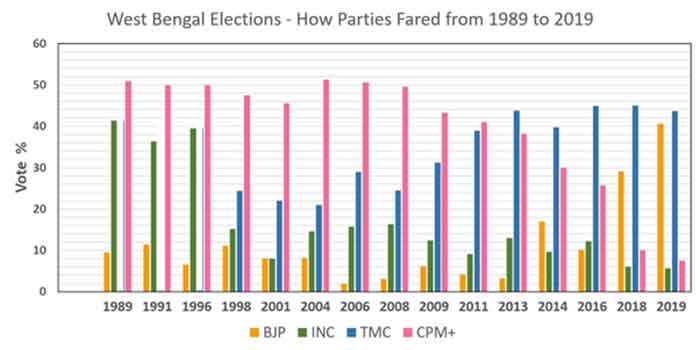
*2004 figure for TMC and BJP and all figures for 2018 are very rough approximations. Source: different sources and one compilation by Ananda Bazar Patrika, May 11, 2018[4].
But what was more intriguing was what may be called an ‘ideological vacuum’, a result for which where several factors were at work, not only the lefts evident desertion of their ideal to serve the working class and peasantry, their open alliance with management of the factories, and rural bourgeoisie. Firstly, the fall of so-called actually-existing-socialisms in Russia and the whole of East-Europe without any external aggression, plus some points of concern regarding what has been happening in China since late 1980s, gave the anti-communists to raise a hypothesis convincingly for many that ‘socialism is a good idea but impracticable’. Secondly, since the late-1980s the rise of Hindu communalism, their continuous misinformation drive emboldened by the TV serials of Ramayana and Mahabharata, the former of which coined the slogan ‘Jai Sri Ram’, came to forefront: we saw AC luxury vans in the garb of Ram Rath (Chariot of Rama) travelling all over India imbuing the youth to launch kar-seva (volunteer duty) to demolish the Babar-i Mosque. Associated with the rise of Hindu militant communalism was the rise of Mujaheddins in the same period, i.e., in late 1980s in Afghanistan and its effect in the sub-continent. Though Bihar CM Mr Lalu Yadav forcibly stopped the cars’ procession in Bihar, West Bengal CM Jyoti babu let the Ram Rath ply in Bengal. After the destruction of Babri masjid, the riot, the prolonged curfew in Kolkata and many other places, showed the state govt’s helplessness, showed the hollowness of this so-called ‘left-bastion’, emptiness of Bengali gentlemen’s and the state’s ‘secular’ image. It only became more prominent in this Modi regime. It is true that the party babus gorgeously celebrated ‘Bengali culture’, what was that had been defined by Bengali Gentlemen, generally Hindu. When the same party repeatedly sermonised: there is no place for communalism in the land of Tagore and Nazrul – it became very hollow as the party was no more standing on workers-peasants struggles – it sounded like phrase-mongering.
The parliamentary lefts including their trade unions never fought religious communalism squarely, and in many cases their own members were not free of such hotchpotch in their consciousness, at least in WB. This can be seen through the election results in WB after 2011, where BJP vote % increase was more correlated with CPM vote % decrease and not that of TMC. Nonetheless, it can be seen that in the period from 1989 till 1999, the BJP maintained a steady presence in WB elections. There were one major (1992) and several minor communal conflagrations during Jyoti babu’s days, and during the left regime pujas were performed within govt premises, even within police station premises; this ‘culture’ did not stop or pause. Trade union members or union directly organised puja events. From 2008 to 2011 the period was keenly contested between the left front and anti-left front, the charged polarised atmosphere pushed anti left front people to vote for TMC, and this can explain BJP’s poorer performance in this intermediate period. The rise of BJP was marked since 2014 election, BJP’s win in consecutive two parliamentary elections gave the BJP-supporters a fillip. Not only several TMC leaders deserted and joined BJP, many left elected representatives also changed side, not to say the ’traditional’ left and also non-left voters. The anti-Muslim was abandoning its covers and coming out leaving erstwhile party-affiliations.
Worse may happen if BJP uses not only hook, but also ‘crook’. There might be more desertion from all other parties. Muslims, largely side with TMC, not only for a strange sense, ‘security’. It is debatable how far the Muslims could advance from their pitiable socio-economic condition in the past: during left regime, Sachar Committee report showed, Muslims being more than 25% in population had a paltry 4.2% share in govt jobs including in schools. Professors Christofe Jaffrelot and A. Kalaiyarasan presented some facts recently[5] and wrote,
“…in West Bengal, while Muslims remain marginalised vis-à-vis other communities, including Dalits, they have indeed gained in public employment — so much so that Muslims getting regular jobs has generated anxiety among the bhadralok.” [Italics mine. Mind the term ‘bhadralok’, Bengali Gentleman, generally an upper caste Hindu, in WB.] His facts:
(i) Muslim representation in government and public sector employment was
6.7% in 2006,
9% in 2012 and
17% in 2018.
(ii) Muslim professors in colleges were
3.12% in 2012-13 and
7.8% in 2018-19.
(iii) Muslim professors in universities were
4% in 2012-13,
7% in 2018-19.
Here we see some reason behind Muslims veering to TMC. Additionally, TMC counts more on effects of some welfare measures taken by TMC govt than a secular image. However, BJP could successfully raise the bogey of ‘Muslim appeasement’ of TMC among a substantial section of Bengali Hindu population.
Yet, if asked: “Is the situation totally hopeless” — the answer is NO. Almost a century and half ago, Bankim Chandra Chattopadhyay described this country (desh – in this case Bengal) as the ‘Hashim Sheikh and Rama Kaibartta’, two names, one a Muslim and another OBC/SC[6] Hindu, both food-producers. Now also most of the producers of roti, kapda aur makaan and most of the workers in transport, coal-petroleum sector, electricity and all necessities belong to these categories, along, of course, with workers belonging to tribes and other nationalities. Objective situation necessitates their united struggle against the wealthy exploiters. Through this struggle not only unity-for-the-sake-of-struggle will materialise, but also a different, higher consciousness. And through this Bengal as well as India can make real changes and advance.
[1] Sherman, Taylor C. (2013) From ‘grow more food’ to ‘miss a meal’: hunger, development and the limits of post-colonial nationalism in India, 1947-1957. South Asia: Journal of South Asian Studies, 36 (4). pp. 571-588. DOI: 10.1080/00856401.2013.833071
This version available at: http://eprints.lse.ac.uk/56149/
[2] https://bangla.hindustantimes.com/elections/west-bengal-assembly-election-2021/west-bengal-assembly-election-2021-narendra-modi-mentioned-asansol-riots-in-his-speech-at-asansol-31618644701919.html
[3] https://www.frontierweekly.com/views/jan-21/13-1-21-CPIM%20can%20never%20ever%20forget%20their%20Corporate%20friends.html
[4] https://www.anandabazar.com/west-bengal/bengal-panchayat-election-2018-party-wise-vote-share-from-2008-2016-in-west-bengal-dgtl-1.795526
[5] https://indianexpress.com/article/opinion/columns/minority-report-polarisation-in-the-bengal-polls-could-have-repercussions-for-the-states-politics-7275463/
[6] Chashi (peasant) Kaibarttas are OBC, Jele (fisherman) Kaibarttas are SC.
Sandeep Banerjee is an activist who writes on political and socioeconomic issues and also on environmental issues. Some of his articles are published in Frontier Weekly. He lives in West Bengal, India. Presently he is a research worker. He can be reached at [email protected]
GET COUNTERCURRENTS DAILY NEWSLETTER STRAIGHT TO YOUR INBOX

